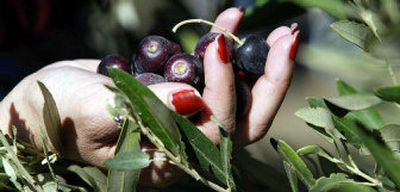California’s crop of table olives is the pits

If you ask anyone in the table olive industry, the five best ways to serve olives are on your fingertips.
But the smallest California table olive crop in at least 25 years is going to make decorating fingers with the black globes more expensive.
The U.S. Department of Agriculture estimates that this year’s olive harvest, which began this week, will reach just 50,000 tons – the lowest since 1981 and only 35 percent of what was picked last year.
Growers and canners predict that it will fall even lower, maybe to 35,000 tons or less as farmers decide that some trees in their orchards are so sparse that it doesn’t make financial sense to pay workers to comb through them.
“We have seen pretty much a 100 percent crop failure,” said Chris Henderson, general manager of Genoa Farms in Tehama County. “This is quite an economic blow. The crop is our payday of the year and it’s not there.”
“This is going to show up in higher prices” at retail, said Bill McFarland, senior vice president of sales and development for Musco Family Olive Co., canner of the Black Pearls brand.
McFarland said consumers would probably see rising prices for olives before Thanksgiving, depending on what big supermarket chains do. A six-ounce can of extra large olives retails for about $2, but is frequently on sale. Instead of raising prices, retailers may limit the discounts, he said.
Two regions of California produce virtually all of the nation’s table olives and a good portion of what goes on pizzas and in salad bars of restaurants, said Adin Hester, president of the Olive Growers Council in Visalia.
Trees in Tehama and Glenn counties started to bud earlier than usual during an unseasonably warm January. A February frost killed much of the new growth.
Farther south in Tulare, Madera and Fresno counties, a series of storms in late April and May washed the blossoms off the trees, preventing pollination.
“It is the worst I have ever seen,” said Bill Krueger, a veteran farm adviser with University of California Cooperative Extension in Glenn County.
California’s burgeoning olive oil trade will be scrambling to find fruit, but isn’t likely to take as big a hit as the table olive growers.
“We know our crop is off about 25 percent and I have other oil producers calling asking if I know where they can get some fruit,” said Alan Greene, general manager of California Olive Ranch in Oroville, the state’s largest maker of olive oil.
But the margins on oil are much higher than on canned olives, and warrant picking through an orchard even when the fruit is sparse, he said.